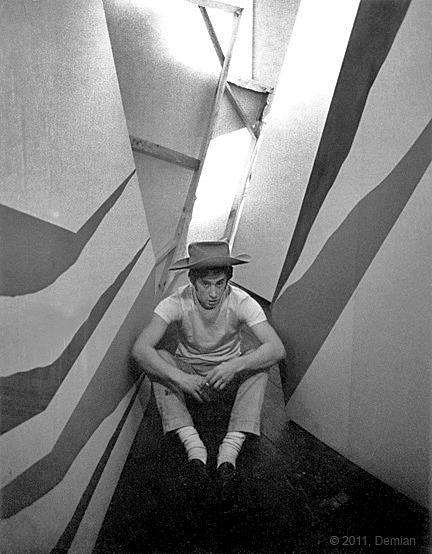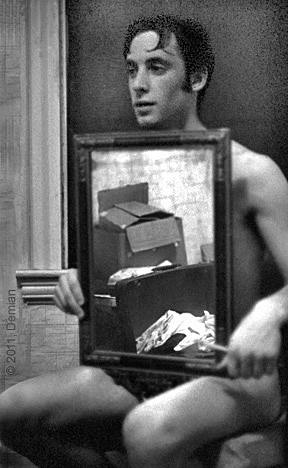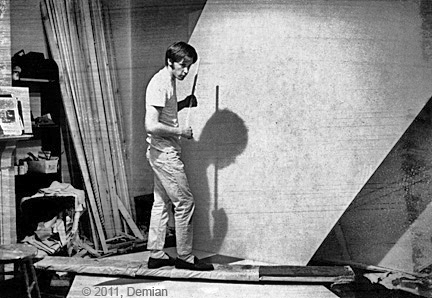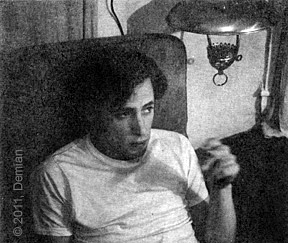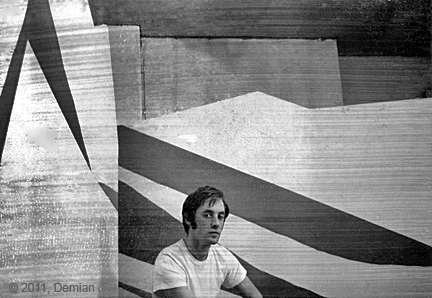|
From the Intaglio, April 1966
The Intaglio interviewers have discovered a young, sensitive promising talent. Neil Jenney, unable to work in the school classroom situation, has turned out, in his Worthington St. studio, a staggering amount of significant paintings.
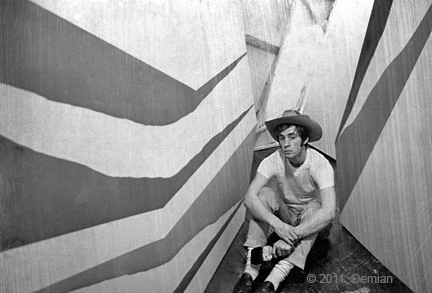 This image was also published in an art gallery magazine called
This image was also published in an art gallery magazine called
the Gagosian, the February-April 2013 issue, on page 56.
Demian:
How long have you been seriously painting?
Neil Jenney:
Since I was about fourteen. I painted on junk paper.
Demian:
Does it bother you that most of your work is too large to be removed from your studio and that few people will see it?
Neil Jenney:
No, it makes me happy because most of it is pretty bad. Iíve decided I donít want to sell my paintings. I want to keep them all!
Burwen:
Do you plan to go into the Painting Department?
Neil Jenney:
Iím seriously thinking of leaving school. One problem is that they take attendance. Itís bad because some days you just have to do something important. But then you have to be there even though instruction wouldnít help at all. Then the inspiration is lost and it becomes a waste of time.
Gail Burwen:
What about your courses?
Neil Jenney:
Very few courses at Mass. Art pertain to contemporary thought. Many are still from the Renaissance era and donít relate in any way to modern man. As Iím a modern man the courses donít help me in evaluating myself. I think Art History is the most valuable course at Mass. Art. I used to have blocks against many kinds of art, especially Egyptian sculpture. I didnít think I could ever like Egyptian sculpture. Iím the one who made myself do it. The teacher opened my eyes, but I made myself do it.
Demian:
Are you aware of the New York schools of environments and happenings?
Neil Jenney:
Yes, I was aware of these schools while I was in high school as an outgrowth of the Dada movement. I was interested in Schwitterís work ó his Merz environment. I seem to be involved in Happenings, especially when Iím alone, especially in this room. I spend about fourteen hours a day in this room thinking though I might actually work about an hour. Iím surrounded by my paintings and they come alive like the alphabet of my past life.
Gail Burwen:
Does your work relate to that of Ellsworth Kelly and Jack Youngerman?
Neil Jenney:
Not as much to Kelly as to Youngerman. Kenneth Noland was a big influence on me. Many people think Iím just a great eclectic, and I can see their point, but I know deep down theyíre wrong. Iíve learned so much from whatís already been done. It just helps me to advance faster. Mass. Art students product an enormous amount of trash mainly because they don't know what trash is. They don't look at art. At least they donít look at art in a juxtaposition to themselves. They donít know whatís good and bad even for them.
Gail Burwen:
Do you paint in school?
Neil Jenney:
I got a ďDĒ in painting. But I deserved it because I didnít paint in school, there's no motivation there. It's bad because I had a dedicated teacher who was interested in what I could do.
Gail Burwen:
What will you do if you leave school?
Neil Jenney:
I want to paint, but the army holds no fascination for me. Iíll probably go to school where they donít take attendance.
Bill Skurski:
How many of the large canvases are in this series and how long have you been working on them?
Neil Jenney:
Since January, there are ten or eleven.
Bill Skurski:
Why do you work so large?
Neil Jenney:
I feel more comfortable with large canvases. You can modulate more theoretical space with physical space. Iím trying to create a total environment. Iím working on canvases for corners and ceilings of rooms. So you can look both ways in a corner and see this thing looking at you. I guess in my subconscious I just want to be noticed.
Demian:
Why not go to New York where the action is?
Neil Jenney:
As far as Iím concerned the action is right in this room. I think I could progress faster if I could do paintings that come out the way I want them to. Iíve had a couple of successful shapes. I paint forms inside to relate to outside forms. Itís difficult to relate them when you've been used to painting on 90 degree angles all your life. There are about two successful paintings which are really monumental to me because they came out just the way I wanted them to.
| 
